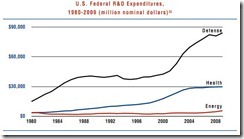The deficit is not the only thing threatening America’s future or the economy.
I’m not referring to ideology-driven agendas in many states including my own to gut conservation and environmental regulation blind to the fact that three in four Americans are worried about water and air pollution.
As impressed as I am with some of his thinking, I was disappointed when Representative Paul Ryan’s budget solution didn’t include the self-funded bipartisan energy proposal I finally got to in the stack of reading that accumulated during one of my two 6,000-mile-cross-country trips.
Anyone involved in visitor-centric economic and cultural development to fuel revenues for local governments knows there is a third alternative to the tired slogan, “it is a debt problem, not a revenue problem” or the equally worn alternative of “raise taxes.”
The third way is to fuel the economy, the answer to the economy is a solution to energy, and now that cap and trade is dead and “drill, baby drill” is just stupid, the answer to energy independence is innovation.
To President Obama’s credit, he included parts of the energy alternative, jointly proposed by scholars on the right, left and in the middle, in his proposal that reduces the deficit by a trillion dollars. But also as one post on the Internet noted with a call for more energy research, expanding the tax credit for corporate R & D, training 100,000 new science and math teachers and expanding Internet access to 98% of Americans.
But it is still far from being robust enough to achieve what was proposed in the bipartisan energy report..
For skimmers and those unwilling to even crack the 34-page report, which unfortunately includes far too many lawmakers, here are some take-aways from a self-funded framework that would make “clean energy cheap and abundant and secure America’s energy future:
- First, the costs of between $15 and $25 billion per year (less than a third of what we devote to defense-related research alone,) can be paid for without adding to the deficit by :
- phasing out subsidies (read the report)
- modestly increasing royalties charged to oil and gas companies
- placing a small fee on imported oil
- establishing a small surcharge on electricity sales and
- dedicating revenues from a small carbon price of $4-$5 per ton
- Investing in energy science education to increase the number of scientists working on innovations or basic science discoveries upon which the private sector can innovate.
- Overhauling the energy innovation system including emulation of what works so well with health research institutes like the National Institute of Environmental Health Sciences based in my home of Durham NC and in DARPA
- Reforming energy subsidies and using military procurement and competitive deployment incentives to drive price declines much like those that have fueled advances in computers, GPS, cellular telephony and the Internet.
As the report notes in part, our economic advances through history have relied on approaches like this such as when the Federal Government enabled:
-a national rail network, the homestead act and land-grant colleges act under President Lincoln and in the midst of the Civil War.
- the aviation industry under President Wilson
- hydroelectric dams under both President Hoover and President F.D. Roosevelt
- nuclear energy under President Roosevelt and President Eisenhower
- the Interstate highway network under President Eisenhower
- advances in space-related technology under President Eisenhower and President Kennedy
- semiconductor development under President Kennedy and President Reagan and
- health research under President Clinton and President G.W. Bush.
There remain indispensible ways the Federal government can fuel the economy by securing America’s energy future and erase the deficit.
No comments:
Post a Comment